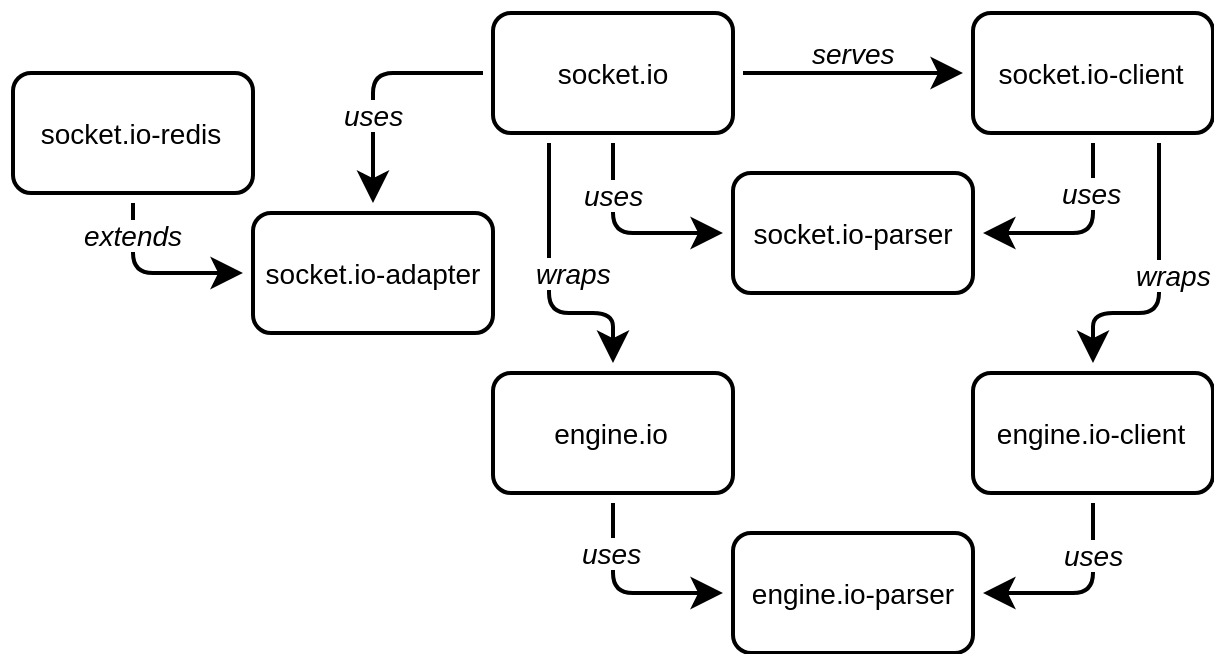Internals overview
Dependency graph
The Socket.IO codebase is split across several repositories:
- https://github.com/socketio/socket.io
- https://github.com/socketio/socket.io-client
- https://github.com/socketio/socket.io-parser
- https://github.com/socketio/socket.io-adapter
- https://github.com/socketio/socket.io-redis
- https://github.com/socketio/engine.io
- https://github.com/socketio/engine.io-client
- https://github.com/socketio/engine.io-parser
The following diagram displays the relationships between each project:

Each project brings its own set of features:
engine.io-parser
This is the JavaScript parser for the engine.io protocol encoding, shared by both engine.io-client and engine.io.
The specification for the protocol can be found here: https://github.com/socketio/engine.io-protocol
engine.io
Engine.IO is the implementation of transport-based cross-browser/cross-device bi-directional communication layer for Socket.IO.
Its main feature is the ability to swap transports on the fly. A connection (initiated by an engine.io-client counterpart) starts with XHR polling, but can then switch to WebSocket if possible.
It uses the engine.io-parser to encode/decode packets.
engine.io-client
This is the client for Engine.IO, the implementation of transport-based cross-browser/cross-device bi-directional communication layer for Socket.IO.
It runs in both the browser (including HTML5 WebWorker) and Node.js.
It uses the engine.io-parser to encode/decode packets.
socket.io-adapter
This is the default Socket.IO in-memory adapter class.
This module is not intended for end-user usage, but can be used as an interface to inherit from other adapters you might want to build, like socket.io-redis.
socket.io-redis
This is the adapter using the Redis Pub/Sub mechanism to broadcast messages between multiple nodes.
socket.io-parser
A socket.io encoder and decoder written in JavaScript complying with version 3 of socket.io-protocol. Used by socket.io and socket.io-client.
socket.io
Socket.IO brings some syntactic sugar over the Engine.IO "raw" API. It also brings two new concepts, Rooms and Namespaces, which introduce a separation of concern between communication channels. Please see the associated documentation there.
By default, it exposes a browser build of the client at /socket.io/socket.io.js.
It uses the socket.io-parser to encode/decode packets.
socket.io-client
This is the client for Socket.IO. It relies on engine.io-client, which manages the transport swapping and the disconnection detection.
It handles reconnection automatically, in case the underlying connection is severed.
It uses the socket.io-parser to encode/decode packets.
Under the hood
Connection
const client = io('https://myhost.com');
The following steps take place:
on the client-side, a new
engine.io-clientinstance is createdthe
engine.io-clientinstance tries to establish apollingtransport
GET https://myhost.com/socket.io/?EIO=3&transport=polling&t=ML4jUwU&b64=1
with:
"EIO=3" # the current version of the Engine.IO protocol
"transport=polling" # the transport being established
"t=ML4jUwU&b64=1" # a hashed timestamp for cache-busting
- the
engine.ioserver responds with:
{
"type": "open",
"data": {
"sid": "36Yib8-rSutGQYLfAAAD", // the unique session id
"upgrades": ["websocket"], // the list of possible transport upgrades
"pingInterval": 25000, // the 1st parameter for the heartbeat mechanism
"pingTimeout": 5000 // the 2nd parameter for the heartbeat mechanism
}
}
- the content is encoded by the
engine.io-parseras:
'96:0{"sid":"hLOEJXN07AE0GQCNAAAB","upgrades":["websocket"],"pingInterval":25000,"pingTimeout":5000}2:40'
with:
"96" # the length of the first message
":" # a separator between length and content
"0" # the "open" message type
'{"sid":"hLOEJXN07AE0GQCNAAAB","upgrades":["websocket"],"pingInterval":25000,"pingTimeout":5000}' # the JSON-encoded handshake data
"2" # the length of the second message
":" # a separator between length and content
"4" # the "message" message type
"0" # the "open" message type in Socket.IO protocol
the content is then decoded by the
engine.io-parseron the client-sidean
openevent is emitted at theengine.io-clientlevela
connectevent is emitted at thesocket.io-clientlevel
Upgrade
Once all the buffers of the existing transport (XHR polling) are flushed, an upgrade gets tested on the side by sending a probe.
GET wss://myhost.com/socket.io/?EIO=3&transport=websocket&sid=36Yib8-rSutGQYLfAAAD
with:
"EIO=3" # again, the current version of the Engine.IO protocol
"transport=websocket" # the new transport being probed
"sid=36Yib8-rSutGQYLfAAAD" # the unique session id
a "ping" packet is sent by the client in a WebSocket frame, encoded as
2probeby theengine.io-parser, with2being the "ping" message type.the server responds with a "pong" packet, encoded as
3probe, with3being the "pong" message type.upon receiving the "pong" packet, the upgrade is considered complete and all following messages go through the new transport.